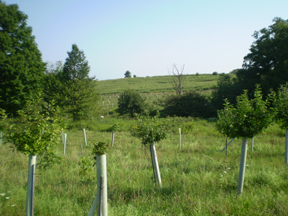In Northeast Pennsylvania the oldest USDA Conservation Reserve Enhancement Program (CREP) contracts, for riparian buffers and tree plantings, are 5+ years old.
There were 902 acres of forested riparian buffers installed (planted), in the state of Pennsylvania during the 2011-12 CREP program year.

CREP trees with plastic tree tubes
These CREP riparian buffer plantings, areas along streams, are all native species of shrubs and trees. The possible selection of over 50 different types of trees and shrubs in the riparian buffers has lead to many different tree sizes and configurations as the trees emerge from the tops of the 5’ plastic protective tubes. On some of the plantings the trees were growing out of the top during the first year of planting and other trees have yet to reach a 5’ height. There are many different reasons for that which could include: the size of the planting stock, the soil and water conditions, grass and weed competition, and the landowner’s maintenance on the planted stock.
What are the USDA’s expectations of the landowners who own these trees and shrubs? There are contractual expectations that 70% or more of the trees will be alive after the first year. The landowners have a 3 year responsibility for keeping a 3’ diameter area around the trees mowed or sprayed with an herbicide to keep the grass/weeds under control. After the 3 year time period the landowner should conduct yearly maintenance deciding for themselves if there is a need for some mowing or herbicide weed control. The landowner should also do yearly or semi-yearly checks on the plastic tubes to make sure they and the enclosed trees are upright. The tube should also be inspected for any accumulations of leaves, bee’s nests, ant nests and even mouse nests all of which should be removed. Bruce Bonnice, a local tree planter and CREP participant, living in Jessup Twp. Susquehanna County, has brought it to the USDA Natural Resources Conservation Services local office attention, “… that ant and mouse nests and the accumulations of leaves are hindering the growth of and/or killing some the tree due to excess moisture which is creating tree rot.” The bees, ants and animal nests could also hold moisture and lead to bark chewing, by the small and larger animals, on the tree. The landowner should also check to see that the trees main leader is growing upwards, this may seem to be a given but sometimes the leaves and nests actually turn the leader downward and for a while it grows in that direction.
Landowners can remove the tree tubes when the main leader is 1” in diameter as in relation to the top of the tube. One other consideration is that of wildlife and the fact that buck may rub on these newly unprotected trees and rabbits, mice and voles may chew on the trees. Landowners should also consider leaving the tree stake in place, if they remove the tube, and then using a strip tie to attach the tree to the existing stake. Landowners should also check the bottoms of the tubes to make sure that the lower part of the tree is not being restricted by the tube. In most instances the tubes have perforations, on their entire length, which will allow the tree to bust the plastic holding them but sometimes this part of the tube may need the landowners knife to help cut them free!
If the landowners do these simple maintenance measures their young forests will be growing up quickly and providing the shade to help make cooler waters in the streams and increased wildlife habitat and food that they were designed to do.














